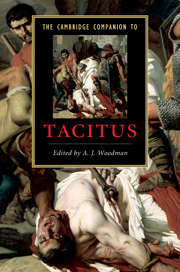Book contents
- Frontmatter
- Introduction
- Part I Contexts
- Part II Texts
- Part III Topics
- Part IV Transmission
- 16 From manuscript to print
- 17 Tacitus and political thought in early modern Europe, c. 1530-c. 1640
- 18 Gibbon and Tacitus
- 19 A dangerous book: the reception of the Germania
- 20 Tacitus and the twentieth-century novel
- 21 Tacitus’ Syme
- Chronological table
- Abbreviations and bibliography
- Index
16 - From manuscript to print
from Part IV - Transmission
Published online by Cambridge University Press: 28 March 2010
- Frontmatter
- Introduction
- Part I Contexts
- Part II Texts
- Part III Topics
- Part IV Transmission
- 16 From manuscript to print
- 17 Tacitus and political thought in early modern Europe, c. 1530-c. 1640
- 18 Gibbon and Tacitus
- 19 A dangerous book: the reception of the Germania
- 20 Tacitus and the twentieth-century novel
- 21 Tacitus’ Syme
- Chronological table
- Abbreviations and bibliography
- Index
Summary
The dates at which each of Tacitus' works was published is not known for certain, but it is generally accepted that they were written and published in a period of roughly twenty years, beginning in 98 (the year after his consulship) and in the order opera minora ('lesser works': Agricola, Germania, Dialogus), Histories, Annals . Though Tacitus was well known in his lifetime as a public figure, the prophecy of his friend, Pliny the Younger, that his histories would be immortal (Ep. 7.33.1) seemed unlikely to be fulfilled, for Tacitus was never a popular author, and during the next four centuries there are only a few references to him by name and an even smaller number of quotations from him. According to a statement in the fourth-century Historia Augusta the emperor Tacitus (275-6) ordered that copies of all Tacitus' works were to be made and placed in public libraries. Though that statement may not be literally true, a germ of truth may lie behind it, namely, that at that time works of Tacitus were scarce and hard to come by. The only significant sign of a Tacitean influence in this period is that the late fourth-century historian, Ammianus Marcellinus, a Greek by birth, but writing in a highly individualised Latin style, proclaimed that his work continued the narrative of events from where Tacitus had left off. However, one statement from late antiquity is of importance for the manuscript tradition.
- Type
- Chapter
- Information
- The Cambridge Companion to Tacitus , pp. 241 - 252Publisher: Cambridge University PressPrint publication year: 2010
- 4
- Cited by

